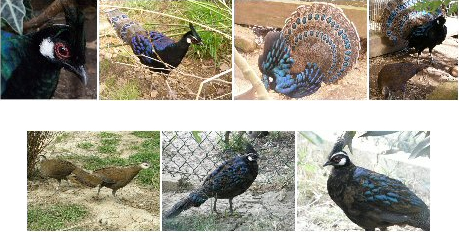Other Names: Napoleon’s Peacock-Pheasant; The specific name napoleonis now has priority over emphanum. Source – Dickinson, E. C. (2001): The correct scientific name of the Palawan Peacock-Pheasant is Polyplectron napoleonis.
Range: The island of Palawan in the Philippines.
Subspecies: There are no subspecies recognized, but males with white supercillia (often referred to as double-barred in captivity) are sometimes given subspecies status as nehrkornae. This is disputed and the variation is probably insignificant.
Habitat: Forested areas
Description: Unmistakable from the other species in the genus. The crest is long and pointed which is dark metallic green as is the crown and neck; the facial skin around the eye is bright red with a white patch under the eye. Some males will have another white patch or bar above the eye that is parallel with the patch below (sometimes extending down the neck), these birds are often referred to as “Double-barred” (see subspecies above). The breast, mantle, flanks and wings are dark metallic greenish-blue and black; there are no ocelli on the rump, rather solid vermiculations of white, black and chestnut. The tail is similar in color with large blue-green ocelli sperated by a black band; the tip of the tail is buff.
Description, Female: Very drab in comparison to the male. Her crest is shorter and often held flat; her face is pale gray that extends from above the eyes to the throat. The rest of the plumage is dark brown, with no ocelli.
Breeding Season: Begins in March in warmer climates and can last into August.
Breeding Age: Males can be sexually mature the first year, although it may take up to three years to fully develop the adult plumage; hens will not often lay until they are two.
Clutch Size: 2 to 5 eggs; buff white in color.
Incubation Period: 18-19 days.



